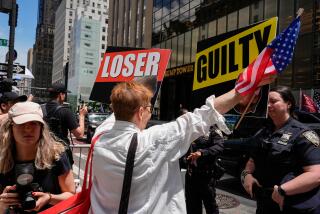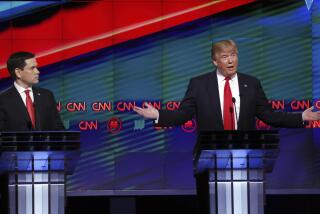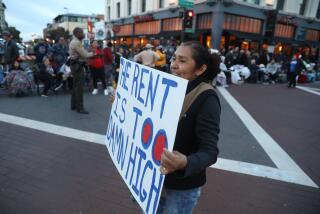Income Share Debate Waged Anew
I have been watching with growing interest a debate currently raging among economists, politicians and journalists over whether there has been a trend toward inequality of income and wealth in the United States in recent years. The authors of a recent study prepared for the Joint Economic Committee of Congress maintain that, despite the impressive number of new jobs created under Reaganomics, the vast majority were at the very lowest end of the wage scale. As a result, the study concludes, the typical wage earner in America is worse, not better, off than before.
For some reason, this study has generated far more heat than one might have expected even one or two years ago. Not surprisingly, there is zero agreement on the issue. The combatants can’t even agree on definitions. But that’s not unusual. It’s been going on this way for hundreds of years.
There never has been nor can there be any analytical resolution of this debate because it does not lend itself to factual analysis. It’s a state of mind, and it’s relative: It depends on who and where you are. Furthermore, it’s cyclical. The battle for income share within societies simmers just beneath the surface even in the best of times. It erupts with a vengeance, however, when economies stagnate and the growth of income grinds to a halt. It is no accident that most socialist experiments have been a response to economic stress or decline.
About the best description of this ebb and flow comes from one of my favorite books: the late Will and Ariel Durant’s “The Lessons of History.” In discussing economics and history, they step off with the observation that, in terms of ability, all men are not created equal. “Since practical ability differs from person to person, the majority of such abilities, in nearly all societies, is gathered in a minority of men. The concentration of wealth is a natural result of this concentration of ability and regularly recurs in history. The rate of concentration varies . . . with the economic freedom permitted by morals and the laws. Despotism may for a time retard the concentration; democracy, allowing the most liberty, accelerates it.” Indeed, they note, “liberty and equality are like buckets in a well. When one goes up the other goes down.” Finally, they say, “in progressive societies the concentration may reach a point where the strength of number in the many poor rivals the strength of ability of the few rich; then the unstable equilibrium generates a critical situation, which history has diversely met: by legislation which redistributes the wealth or by revolution which redistributes the poverty.”
In a political context, this view is shared by political historian Arthur M. Schlesinger Jr. He identifies roughly 30-year cycles in the yin and yang of conservative and liberal politics in America. He notes: “Just as the 1980s were a re-enactment of the 1950s, the Eisenhower time was a re-enactment of the Harding-Coolidge time of the 1920s. So at 30-year intervals--Theodore Roosevelt in 1901, F.D.R. in ‘33, Kennedy in ‘61--we have a swing from private interest . . . to public purpose.” “Each phase,” he says, “breeds its distinctive contradictions.” Speaking of the present phase, now seen to have crested, he observes: “Epochs of private interest are characterized by undercurrents of dissatisfaction. . . . Segments of the population fall behind in the acquisitive race. . . . Problems neglected become acute. . . . People grow . . . weary of materialism as the ultimate goal. The vacation from public responsibility replenishes the national energies. . . . People begin to seek meaning in life beyond themselves. . . . They are ready for a trumpet to sound . . . a detonating issue--some problem growing in magnitude and . . . beyond the capacity of the market’s invisible hand to solve.”
If the Durants were right in their observations, and instinct suggests they were, it probably is true that the conservative consensus of free markets, free trade, deregulation, tax cuts and less government interference that germinated in the early ‘70s and accelerated dramatically in the ‘80s has produced a tendency toward greater inequality of income. I doubt we’ll ever know for sure. In any case, these things seem to be self-correcting, as the Durants and Schlesinger have suggested.
Which brings me to the upcoming presidential election campaign. Gary Hart, in his formal announcement of candidacy for the Democratic nomination, said: “I believe our leaders in the future must match reason with rhetoric and policy with passion and foresight with hindsight.” While it’s not entirely clear which side of that alliteration he is on, or even what it means, he did go on to say that “we’ve let personal greed replace a sense of social justice and equity and the national good.” Even the bishops of the Roman Catholic Church have joined the debate with their recent pastoral letter, “Economic Justice for All: Catholic Social Teaching and the U.S. Economy,” in which they find the “disparities of income and wealth in the United States to be unacceptable.”
Presidential contender Bruce Babbitt maintains that “when Rhodes scholars are arrested for insider trading, that contributes to this populist sentiment that a privileged class is getting rich at the expense of the rest of the economy.” While most people haven’t a clue what Boesky and others actually did, they feel that, somehow, they were ripped off. Articles such as the recent Business Week survey of corporate chief executive incomes or a recent newspaper piece about 30-year-old yuppie investment banker couples feeling poor on $600,000 per year don’t help, either.
What does all of this mean for the post-1988 economy? First, we probably have seen all we’re going to see of income tax reductions for years to come. History assures us, in any case, that low taxes on high incomes is not a lasting proposition. Whether they will last even through the end of this decade is debatable. Second, attempts to balance the federal budget will be even more halfhearted than before, if you can imagine it, and the focus of reduction efforts will fall ineluctably on the defense budget. Third, deregulation is likely to grind to a halt, protectionism may proliferate in a hundred subtle forms, and governments will intervene again in areas of antitrust, safety, environment, job security and the like.
Is this all bad? Kennedy’s activist “New Economics” in the early ‘60s, despite the hue and cry about inflation and other forms of pending economic disaster, in fact turned out to be a kind of economic Camelot, the best of all worlds--sustained high growth and high employment without inflation. Can we pull it off again? I don’t know, but I’ll bet we’re going to try.
As Ralph Waldo Emerson wrote in 1841: “The two parties which divide the state, the part of conservatism and that of innovation, are very old, and have disputed the possession of the world ever since it was made. . . . Now one, now the other gets the day, and still the fight renews itself as if for the first time, under new names and hot personalities.”
More to Read
Get the L.A. Times Politics newsletter
Deeply reported insights into legislation, politics and policy from Sacramento, Washington and beyond. In your inbox three times per week.
You may occasionally receive promotional content from the Los Angeles Times.










